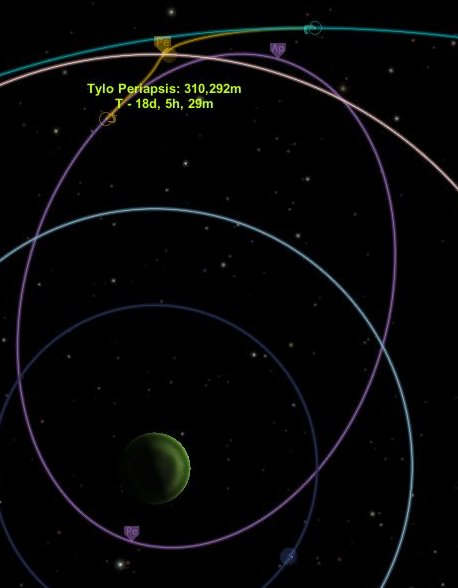Difference between revisions of "Tutorial: Gravity Assist/zh-cn"
m |
|||
| Line 22: | Line 22: | ||
祝贺你,你现在会进入一条大致飞向Duna的轨道,而又为返程省下了足够的燃料。如果希望返回Kerbin,你可以利用Ike进行类似的机动。 | 祝贺你,你现在会进入一条大致飞向Duna的轨道,而又为返程省下了足够的燃料。如果希望返回Kerbin,你可以利用Ike进行类似的机动。 | ||
| − | == | + | == 反向引力助推 == |
| − | [[File:Gravity Assist.svg|right|thumb|200px| | + | [[File:Gravity Assist.svg|right|thumb|200px|从目标卫星的前方飞掠进行减速,从后方飞掠进行加速]] |
| − | + | 假如你以合适的轨道进入Duna-Ike行星系统后,你可以利用反向引力助推进行减速飞行。具体办法就是进行一次Ike的飞掠。记住我们的目标是减速而非加速,因此需要把轨道近点放在Ike轨道的前方而不是后方。 | |
== Powered Gravity assist == | == Powered Gravity assist == | ||
Revision as of 04:45, 24 June 2013
引力助推是一种非常节约燃料的加速(或减速)机动方式。这种机动就是,当位于天体的引力范围球体之内时,它会对飞船产生一定的牵引力,从而相应为飞船产生加速(或减速)的效果。当你飞离某颗行星,如果它有卫星,那么我们就可以利用该卫星进行引力助推机动,从而节约大量的燃料。
- 长度:30分钟
- 难度:适中
- 对应版本:0.18.4
如何进行
在这个例子里,我们要离开Kerbin,利用Mün完成引力助推,并进入前往Duna的轨道。通常,你需要把轨道远点高度提升到八千五百万公里才能脱离Kerbin。用这个办法,我们只需要进入Mün轨道(一千两百万公里)就可以。这样可以为你节约相当于几百m/s delta-v的燃料。
- 飞船进入环Kerbin低圆周轨道;
- 缩小图像直到可以看到Kerbin的公转轨道;
- 按照"Going to the Mün"教程中学到的方法,安排前往Mün的飞掠轨道,需要注意的一点是,应该注意到达Mün时,它正向你需要的方向前进。在本例中,我们需要的是飞离太阳的方向,因此在设计轨道时注意Mün的运行方向 —— 即Mün轨道与Kerbin公转轨道交汇的时刻;
- 加速时间,直到抵达Mün的引力范围;
- 现在规划一次轨道校正机动。因为引力助推离目标天体距离越近效果越明显,所以只要不发生碰撞,离Mün越近越好。你的Mün轨道近点应位于Mün运行方向的后方。如果飞船从前方经过Mün,你会减速而不是加速。同时应注意轨道的倾角 —— 太高就会有问题了;
- 加速时间,直到离开Mün的引力范围;
- 观察轨道地图,你会发现飞船现在的轨道比飞掠Mün前变得更长(轨道远点很可能位于Minmus轨道的后方),但它并不是Kerbin的逃逸轨道。你还没有从Mün获得足够的全部速度;
- 所以,再进行一次轨道校正机动,再度飞掠Mün,并尽可能靠近它飞行;
祝贺你,你现在会进入一条大致飞向Duna的轨道,而又为返程省下了足够的燃料。如果希望返回Kerbin,你可以利用Ike进行类似的机动。
反向引力助推
假如你以合适的轨道进入Duna-Ike行星系统后,你可以利用反向引力助推进行减速飞行。具体办法就是进行一次Ike的飞掠。记住我们的目标是减速而非加速,因此需要把轨道近点放在Ike轨道的前方而不是后方。
Powered Gravity assist
To get even more out of a gravity assist, you can perform a powered gravity assist. As you know, accelerating at your periapsis has the greatest effect on your apoapsis. This still applies to your periapsis during a gravity assist. When you accelerate during your fly-by, this fuel is used very efficiently to increase the apoapsis of your final trajectory. This is, however, a very difficult technique, because it is hard to control your final trajectory, even when using a maneuver node.


